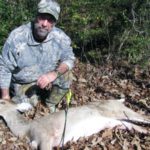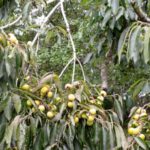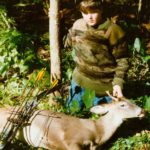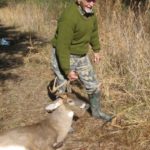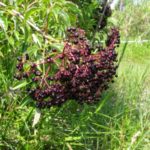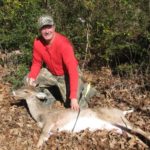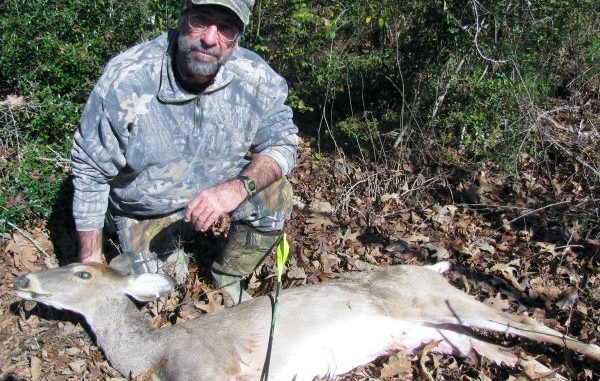
Deer hunters usually search out oak trees dropping acorns, expecting deer to flock to the high-protein nibblets. But early in the season — when the woods are still green — soft mast might be a better option.
Artie’s cousin Cliff was seriously pumped, despite the LSU-Auburn disaster unfolding on Doc’s mega-screen TV.
As Auburn kept stacking up scores, Cliff was tapping his iPad and showing the deer pics around and around and around the room.
Doc’s guests all smiled politely — while Cliff was looking, that is.
As soon as he turned, many of the guests rolled their eyes. Some frowned. Others (especially the women) made gagging faces.
Cliff took many of the pics in the cleaning shed, you see — as often happens with evening-shot deer.
Last Christmas, Cliff had finally gotten into deer hunting at the tender age of 37.
“Man! Dem deer just poured into that food plot every evening from three directions!” he beamed after finally pocketing his iPad and moving toward the keg.
“I had my pick!” Cliff said while the spigot coughed and sputtered up another draft from Doc’s rapidly emptying keg. “Just stuck the ol’ .308 outta da stand’s window — Blam! Dropped him with a neck shot!”
“Ain’t gonna work dat way next weekend, Cliff!” Artie laughed, as he walked by with the platter of teal-k-bobs from the grill.
Cliff’s Christmas hunt, you see, took place on a friend’s lease near Port Gibson, Miss.. His maiden archery hunt was set for the following week at Eddie’s family property in the Florida Parishes piney woods.
After Cliff finished showing off the pic of his very respectable Mississippi 8-point, he started showing off pics of his spanking new crossbow that would be making its maiden hunt the following week.
Newly-smitten with deer hunting just as the previous season was ending, Cliff naturally wanted to partake of it again at the earliest opportunity. Naturally, this meant Louisiana’s archery season, something he’d traditionally ignored at the expense of fishing and LSU football.
So Artie kept funning with his increasingly annoyed cousin.
“My guess is, Cliff, after you sample Southeast Louisiana deer hunting — especially bow hunting — there’ll be a crossbow for sale on eBay and Louisiana Sportsman’s ads: ‘Like new! Never fired except at the range’ Well, I’ll be in the maaawket for a crossbow myself. Christmas gift for my nephew, who’s taking up the sport.
“I won’t even bother shopping around now! I know I got a great deal coming!”
Cliff’s answering smile looked a bit awkward. But, actually, his choice of killing instrument wasn’t unusual nowadays.
From St. Francisville around to Denham Springs and eastward through Hammond, Mandeville and Slidell, it’s becoming all too familiar — strip malls and subdivisions sprouting like mushrooms after a rain, with many hunters losing their leases or portions of their leases as a result.
Along with this urban sprawl has come many ugly incidents between the new residents to these quasi-rural subdivisions and people hunting in the vicinity.
Bowhunting provides an accommodation to this problem.
But even if Cliff planned on hunting the exact same area as the previous Christmas — the deer-lousy area around Port Gibson — the contrast in habitat, food-sources, etc., from early October to Christmas would be dramatic, calling for totally different tactics.
Heck, that drastic habitat change even applies from the opener of bow to the opener of gun season. Those few, crucial weeks feature a drastic change in South Louisiana landscape, primarily owing to the rapidly shortening days.
In brief, soft-mast (persimmons, elderberry, French mulberry, poke weed) — so beloved by deer that they often prefer it to fertilized food-plots — disappear almost completely by early November.
Not that Cliff hadn’t chosen the best time to hunt deer in Southeast Louisiana — if not the most-efficient weapon.
“Can’t have it all” as they say.
In brief, if a South Louisiana deer hunter had only one day a year to hunt deer, he’d be wise to make it the day after the first cold front of the year — even if the “cold” barely calls for long sleeves.
For our deer sightings, a 50-degree morning in October is worth 10 30-degree mornings after Thanksgiving (when so many deer have gone nocturnal).
Naturally, this means taking up a bow or crossbow, which meant the chances for Cliff of actually harvesting a deer were drastically reduced as compared to with a gun.
But the likelihood of that adrenaline rush from sighting one at close quarters while anticipating its harvest was pretty good.
And isn’t that a big part — maybe the main part — of a deer hunt?
“Find persimmons and white oak (especially cow oak) acorns, or elderberry and French mulberry bushes in early October,” Pelayo explained to Cliff as the LSU-Auburn disaster finally shut down on Doc’s mega-screen TV, “and you’ve got a natural bait station that’ll outdraw every corn feeder in the parish. The cow or chestnut oaks don’t much grow in our area — but the occasional live oaks that dot the mostly pine savannah area draw early season deer just as well as any white oaks.”
“Ya mean like the oaks in City Paaawk?” Cliff gasped.
“Yep — those very ones,” Pelayo shot back. “Of course, the ones where we’ll be hunting around ain’t nearly as big as da ones in City or Audubon paaawks. But the deer love those little green acorns as soon as they start falling in early October — ya follow what I’m saying?
“Heck man, we find the deer trails converging on these natural live-oak bait stations like the spokes of a wheel converge on the axle. We’ll show you.”
“And Cliff,” Artie interrupted as he finished advocating Les Miles’ firing (and public execution), “be sure to look for poke salad bushes in the area. Deer love ’em. And they love the whole plant: the purple berries, the green leaves and the red stems. In fact, the deer love poke salad as much as does Poke Salad Annie!”
“Ya mean like da song?” asked Cliff, the classic rock aficionado.
Just then Pelayo tapped me on the shoulder and pointed behind me with his chin.
Sure enough: Doc Fontaine — that other fanatical classic rocker — was already on his knees by his five-speaker boom box, rummaging through his CD collection.
“Won’t be long!” Pelayo laughed, waving around the room to call attention to the upcoming musical event.
Down in Louisiana, where the alligators grow so mean.
“There it is!” Artie roared, as the speakers came alive with the classic hit Poke Salad Annie.
There lived a girl, that I swear to the world, made the alligators look tame ….
“POKE SALAD ANNIE!” the room erupted. “Polk Salad Annie! Everybody said it was a shame. Cause her momma was a workin’ on the chain gang!”
Everybody — as you might expect — knew the lyrics.
And Doc’s stunt came not a minute too soon. We’d just watched our Tiger’s get clobbered (41-7) by the Auburn Tigers.
Spencer and a few others of the gang were actually at the game in Alabama, texting us their woe almost minute by minute. As if our own woe wasn’t sufficient! We were watching the game on Doc’s mega-screen!
In brief, we definitely needed a little pick-me-up of some kind — and Polk Salad Annie was just the ticket.
Next morning, Cliff was trudging along behind us as we explained the motions — and rationale — of putting out his climbing stand for the following week’s hunt.
“We notice this sort of early season food transitions time and again,” Pelayo explained. “The persimmons, for instance, won’t last the entire month. And the actual elderberry berries will also be mostly gone — but deer also relish the leaves.”
“Now notice,” Pelayo said, putting his palm about chest high. “There ain’t many leaves or berries below here. That’s about where deer reach when browsing. So, sure, you wanna find these plants. But you also wanna make sure the deer are browsing on ’em.
“If you find much privet, elderberry, poke salad, smilax, French mulberry below this height (he again put his palm at his chest) and it ain’t been browsed. Forget it. Look for another place.”
Cliff seemed impressed.
“Gotcha!” he said with a thumbs-up.
But, in fact, we had no such problem in this area. In brief, that valuable soft mast — those valuable natural food plots — just doesn’t make it much into the gun season in our area.
And most of these were going even faster — from browsing. Perfect. Just what we wanted to see.
Amazingly, we even came upon a white oak that was “putting-out,” as Artie loves to say. In our experience white oak acorns drop a bit longer than do the live oaks — but they seem to be gobbled almost as fast as they drop.
I said gobbled, but this gobbling isn’t exactly like that of the smaller willow, laurel and live oak acorns. Deer usually swallow those whole. Upon gutting your kill, you’ll often find them in that condition (minus the caps) in their first stomachs.
Those huge cow oak (aka swamp chestnut) acorns, however, get popped before being swallowed. Kinda like what we do with a crawfish tail. We pop or squeeze out the meat.
So that’s the telltale sign that deer, rather than squirrels (or along with squirrels), are the ravenous culprits under a cow oak. You’ll find semi-crushed, empty shells lying about, usually amidst several piles of dark, shiny droppings.
Granted, such hotspots with tracks, droppings, etc., can be found in November, December and January. The difference is that when you find these in early October in a relatively sparsely hunted and hard-to-reach area, the chances of daytime visits from deer is about 10 times greater than later in the year, especially on a cool morning.
Alas, as mentioned, cow oaks are very scarce in our area. But browsing sign was everywhere, especially along the trails leading to the persimmon tree grove we’d planned for Cliff’s stand site.
Even better, a little orchard of heavily browsed elderberry sprouted from a nearby creek bank. These touches added enormous allure to the natural bait station we picked for Cliff. It looked like entire deer families were converging on the area.
But just to make sure they didn’t change their pattern, we widely sprinkled the area with 50 pounds of corn along the incoming trails.
Never hurts!
Pelayo opted to hunt about 200 yards away in a grove of three stunted live oaks. As usual when two habitats meet, deer trails appear. Pelayo found a place where the pine savannah met the oak bottom, and he followed the trails to the live oaks, where he set his climber.
Sweating buckets from the hike, despite the early October cold front the following Saturday — and fully expecting to pick a few banana spiders from my neck after settling in — I humped up on my climber about 200 yards away from Cliff’s in a seemingly impenetrable jungle of French mulberry, chinese privet, smilax and muscadine.
The first hour passed slowly. Finally, light came, followed shortly by swarms of squirrels all around me.
The first text came at 8:07.
“Big, fat squirrel right under me,” Cliff texted. “He’s red and brown with a white and black face. Wish I was squirrel hunting!”
“We’ll talk AFTER the hunt” I texted back, hoping he’d take the hint.
At 8:45 I caught movement to my right.
“More squirrels,” I thought to myself while focusing.
Then the adrenalin jolt and shakes kicked in! When I saw the little forks on his head, the shakes really started. When I spotted more movement behind him, they cranked up considerably.
When I saw it was a spike, they went from shakes to near convulsions.
This often happens during October: Smallish bucks hang out together in bachelor groups. They were only 70 yards out and moving down the trail like clockwork, none of that stopping and looking around and nibbling so characteristic of does, especially when escorting their offspring.
I slowly started raising my bow. My movements were those of the proverbial molasses in wintertime. A slight click when I slipped on the release stopped the deer in their tracks, brought their ears up and pointed their eyes directly at me.
I stopped breathing.
Finally, they started ambling slowly again — then they stopped again.
“Why won’t they move?” I asked myself.
Then they resumed their route, a bit more briskly now — and soon were about 40 yards out. But I don’t even contemplate a shot until 25 yards, which meant that controlling my shakes again was becoming impossible.
John Voight drawing on that deer in Deliverance came to mind.
“Another 15 yards, please!” I was saying to myself.
Then they suddenly turned at a right angle to the trail and ambled away into the thickets, never to reappear.
It took about 20 minutes for my shakes to subside, which of course meant the hunt had already been a rollicking success.
At 10:45, my phone beeped. It was Cliff.
Twenty minutes later, we all met at Pelayo’s truck. Cliff had seen three deer — but hadn’t touched the trigger. He could barely talk while explaining that none had gotten quite close enough or presented exactly the perfect angle for a shot.
“We coming back tomorrow!” he gasped.
“Sure!” Pelayo smiled.
Maybe Artie wouldn’t have such a great deal on a Christmas crossbow after all.
